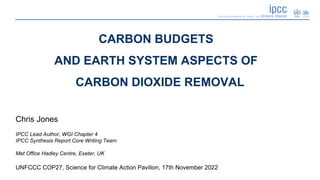
Carbon budgets and earth system aspects of CDR
- 1. Chris Jones IPCC Lead Author, WGI Chapter 4 IPCC Synthesis Report Core Writing Team Met Office Hadley Centre, Exeter, UK UNFCCC COP27, Science for Climate Action Pavilion, 17th November 2022 CARBON BUDGETS AND EARTH SYSTEM ASPECTS OF CARBON DIOXIDE REMOVAL
- 2. • Amount of global warming is proportional to the total (“cumulative”) CO2 emissions • Limiting global warming requires limiting total emissions • There is a finite amount (“budget”) we can emit before we reach a warming level • We had 500 GtCO2 left of our 1.5°C carbon budget • from the start of 2020 • for a 50% chance • Now reduced to 380 GtCO2 WGI Figure SPM.10 Every tonne of CO2 emissions adds to global warming
- 3. Remaining carbon budget is small https://globalcarbonbudget.org/
- 4. Remaining carbon budget is small – required reductions very fast https://globalcarbonbudget.org/
- 5. CDR is not a replacement for deep and rapid emissions reductions • IPCC SR15 Fig SPM.3B Vast majority of action is emissions reduction Small amount of CDR for hard-to-abate residual Land-use term is net of gross emissions and gross removals in AFOLU sector
- 6. CDR is happening already •Deforestation is the main driver of land-use emissions (remaining high at 6.7 ± 1.5 GtCO2 per year for 2012-2021). Forest fluxes from re/afforestation and wood harvest emissions and removals counterbalance approximately half of these emissions (-3.5 ± 1.0 GtCO2 per year). 6.7 ± 1.5 2012-2021 average Gt CO2 per year -3.5 ± 1.0 0.6 ± 0.5 0.8 ± 0.3 Components of land-use change emissions https://globalcarbonbudget.org/
- 7. Scope and implications of different CDR techniques AR6 WGI assessment Fig 5.36
- 8. Scope and implications of different CDR techniques Storage permanence? decades to many millennia AR6 WGI assessment Fig 5.36
- 9. Scope and implications of different CDR techniques Storage potential? Some techniques may sequester multiple GtCO2/yr AR6 WGI assessment Fig 5.36
- 10. Scope and implications of different CDR techniques Non-CO2? Need full GHG assessment of techniques AR6 WGI assessment Fig 5.36
- 11. Scope and implications of different CDR techniques Biophysical effects? AR6 WGI assessment Fig 5.36
- 12. Scope and implications of different CDR techniques Other trade- offs or co- benefits? Air/water quality, biodiversity AR6 WGI assessment Fig 5.36
- 13. • We will need CDR • Both for net-zero and net-negative • We’re doing it now on managed land • All aspects have implications and costs • Land • Water • Nutrients • $$$ • No single technique can solve this singly • Devil is in the detail • Full GHG accounting • Biophysical effects • Uncertainty in carbon budgets- huge uncertainty in future need for CDR – need emissions reductions now Climate system summary of CDR • CDR is not / cannot be a replacement for emissions reduction
Notas del editor
- Good evening, thanks to the organisers and hosts for inviting me to speak tonight
- The more we emit, the more we warm Therefore to stop warming – we must stop emitting The warming we get = depends on the amount we have emitted when we reach net-zero Therefore we have a finite budget – we can work out the emissions which lead to 1.5 degrees and then see how much we’ve got left if we know what we have emitted Latest GCP budget – released last Friday – gives up-to-date status of this
- Updates on the global carbon budget show yet another rise in emissions Increasing more slowly perhaps but we still have not yet peaked, let alone started to fall or reach half… This budget applies regardless of whether we overshoot or not – so we can either keep within it, or we can exceed it and remove CO2 later – the total which leads to 1.5 degrees is the same
- RCB for 1.5 is about 9 years at current emissions rate Simple linear reduction means we need zero by 2040 More ambitious non-CO2 action can buy us time and WGIII has more “realistic” scenarios of the timeline for reductions. But the total budget represents a limit we must adhere too – societal choices only give us wiggle room in terms of the “how” and the “when”, but not the “how much” Therefore we must consider the role of CO2 removal – CDR on these time scales – the implications of this cut across all sectors of science from physical/earth system, to societal to technological etc. We must balance supply and demand aspects
- Showing more real-world timeline for these things – Oliver will present this in detail. We know we need some form of CDR, but we can see there already is some happening – mainly from reforestation on managed land Stress CDR is not an excuse to stop reductions – almost all our effort to net-zero is to stop emitting CDR is then the extra bit to get us the final step (but needs to be developed in parallel)